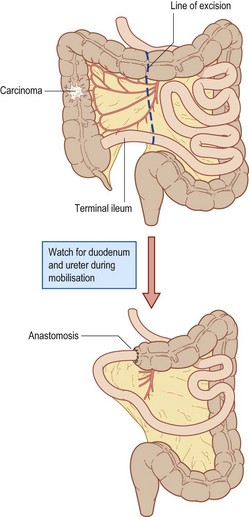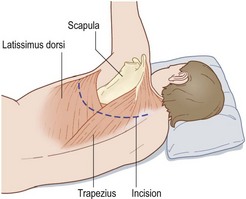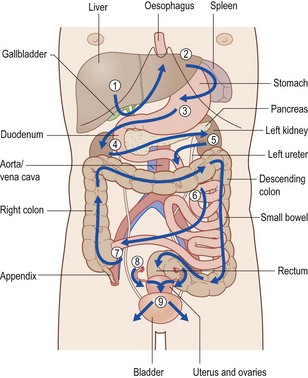25 Important steps in common operations
Generic checklist for any surgical procedure (as formalised in the WHO surgical checklist, see Chapter 1)
• Correct and complete preoperative tests (e.g. FBC, U&E, ECG)
• Group and save/cross-match/clotting
• Hepatitis B, C, HIV status known? MRSA?
• Type of anaesthetic (general, regional block, local infiltration)
• DVT prophylaxis (stockings, LMWH)
• Site marked clearly by surgeon
• Skin preparation (NB allergies)
• Surgeon and staff protection
• Detailed postoperative instructions to medical and nursing staff.
• Incision (midline, transverse, laparoscopic)
• Preliminary laparotomy, laparoscopy
• Determine operability, stage of disease
• Lateral to medial dissection (open procedure)
• Medial to lateral dissection (laparoscopic)
• Radical excision of lymphatic vessels
• Division of terminal ileum, transverse colon
• Ensuring of good blood supply to cut ends
• Anastomosis of ileum to colon (sutures or staples)
• Washout with cytocidals (water, Betadine)
• Return patient in satisfactory condition to recovery unit
• EUA, sigmoidoscopy, proctoscopy and biopsy
• Identify track(s) using probes, dye or H2O2
• Relation to internal/external sphincter
• Low – lay open from external to internal opening
• High – consider laying open lower track
• High – consider seton suture (tight/loose)
• Further options: Fibrin glue insertion, Fistula plug, Mucosal advancement flap
• AND SEEK SENIOR HELP IF IN DOUBT.
• Site incision according to operation
• Ribs are not counted until after muscle division
• Upper lobe fourth/fifth interspace, lower lobe sixth/seventh interspace
• Incision from midline skirting scapula to mid-axillary line
• Divide muscles (two layers) – preserve serratus anterior
• Count ribs, divide periosteum and strip with rougine
• Resect 2–3 cm of rib posteriorly
• Warn anaesthetist, open pleura along length
• Close over two drains (apical and basal)
• Close muscle layers and skin
• Attach underwater drains and re-expand lung
• Return patient in stable condition to recovery.
• Expose hip joint (anterior/posterolateral)
• Open capsule and dislocate joint
• Remove femoral head at angle corresponding to prosthetic shaft
• Ream the femur with broaches
• Prepare acetabulum by excising all soft tissue
• Enlarge acetabulum to fit cup
• Drill keying holes to provide grip for cement
• Insert femoral component into femur
• Close wound in layers with drainage.
Identify structures in order as indicated by arrows:
• liver, gallbladder, right kidney
• oesophagus, fundus of stomach, spleen
• body of stomach, duodenum, pancreas, left kidney
• lesser sac, transverse colon
• small bowel, appendix, aorta, ureters
• descending colon, sigmoid, upper rectum
• uterus, fallopian tubes, ovaries and bladder
• Mark site of pterion burr hole after shaving (3 cm above mid-zygomatic point)
• Incise the scalp and use self-retaining retractor
• Use Hudson brace with perforator













